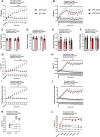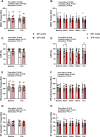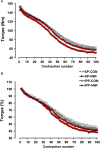Passive heating-induced changes in muscle contractile function are not further augmented by prolonged exposure in young males experiencing moderate thermal stress
- PMID: 38476145
- PMCID: PMC10928533
- DOI: 10.3389/fphys.2024.1356488
Passive heating-induced changes in muscle contractile function are not further augmented by prolonged exposure in young males experiencing moderate thermal stress
Abstract
Background: We investigated the impact of 1) passive heating (PH) induced by single and intermittent/prolonged hot-water immersion (HWI) and 2) the duration of PH, on muscle contractile function under the unfatigued state, and during the development of muscle fatigue. Methods: Twelve young males volunteered for this study consisting of two phases: single phase (SP) followed by intermittent/prolonged phase (IPP), with both phases including two conditions (i.e., four trials in total) performed randomly: control passive sitting (CON) and HWI (44-45°C; water up to the waist level). SP-HWI included one continuous 45-min bath (from 15 to 60 min). IPP-HWI included an initial 45-min bath (from 15 to 60 min) followed by eight additional 15-min baths interspaced with 15-min breaks at room temperature between 75 and 300 min. Intramuscular (Tmu; measured in the vastus lateralis muscle) and rectal (Trec) temperatures were determined. Neuromuscular testing (performed in the knee extensors and flexors) was performed at baseline and 60 min later during SP, and at baseline, 60, 90, 150 and 300 min after baseline during IPP. A fatiguing protocol (100 electrical stimulations of the knee extensors) was performed after the last neuromuscular testing of each trial. Results: HWI increased Tmu and Trec to 38°C-38.5°C (p < 0.05) during both SP and IPP. Under the unfatigued state, HWI did not affect electrically induced torques at 20 Hz (P20) and 100 Hz (P100). However, it induced a shift towards a faster contractile profile during both SP and IPP, as evidenced by a decreased P20/P100 ratio (p < 0.05) and an improved muscle relaxation (i.e., reduced half-relaxation time and increased rate of torque relaxation; p < 0.05). Despite a reduced voluntary activation (i.e., -2.63% ± 4.19% after SP-HWI and -5.73% ± 4.31% after IPP-HWI; condition effect: p < 0.001), HWI did not impair maximal isokinetic and isometric contraction torques. During the fatiguing protocol, fatigue index and the changes in muscle contractile properties were larger after HWI than CON conditions (p < 0.05). Finally, none of these parameters were significantly affected by the heating duration. Conclusion: PH induces changes in muscle contractile function which are not augmented by prolonged exposure when thermal stress is moderate.
Keywords: cardiovascular response; central activation; contractile properties; hot-water immersion; muscle contractility; muscle fatigue; temperature; voluntary muscle activation.
Copyright © 2024 Treigyte, Chaillou, Eimantas, Venckunas and Brazaitis.
Conflict of interest statement
The authors declare that the research was conducted in the absence of any commercial or financial relationships that could be construed as a potential conflict of interest.
Figures







Similar articles
-
Moderate muscle cooling induced by single and intermittent/prolonged cold-water immersions differently affects muscle contractile function in young males.Front Physiol. 2023 Mar 21;14:1172817. doi: 10.3389/fphys.2023.1172817. eCollection 2023. Front Physiol. 2023. PMID: 37025384 Free PMC article.
-
Hot water immersion is associated with higher thermal comfort than dry passive heating for a similar rise in rectal temperature and plasma interleukin-6 concentration.Eur J Appl Physiol. 2024 Apr;124(4):1109-1119. doi: 10.1007/s00421-023-05336-8. Epub 2023 Oct 23. Eur J Appl Physiol. 2024. PMID: 37870668 Free PMC article.
-
Hot But Not Cold Water Immersion Mitigates the Decline in Rate of Force Development Following Exercise-Induced Muscle Damage.Med Sci Sports Exerc. 2024 Dec 1;56(12):2362-2371. doi: 10.1249/MSS.0000000000003513. Epub 2024 Jul 4. Med Sci Sports Exerc. 2024. PMID: 38967392 Clinical Trial. English, French.
-
Potential role of passively increased muscle temperature on contractile function.Eur J Appl Physiol. 2022 Oct;122(10):2153-2162. doi: 10.1007/s00421-022-04991-7. Epub 2022 Jun 30. Eur J Appl Physiol. 2022. PMID: 35771296 Free PMC article. Review.
-
The effect of metabolic alkalosis on central and peripheral mechanisms associated with exercise-induced muscle fatigue in humans.Exp Physiol. 2015 Apr 20;100(5):519-30. doi: 10.1113/EP085054. Exp Physiol. 2015. PMID: 25727892 Review.
Cited by
-
Cell-free DNA kinetics in response to muscle-damaging exercise: A drop jump study.Exp Physiol. 2024 Aug;109(8):1341-1352. doi: 10.1113/EP091986. Epub 2024 Jun 14. Exp Physiol. 2024. PMID: 38875105 Free PMC article.
References
LinkOut - more resources
Full Text Sources

